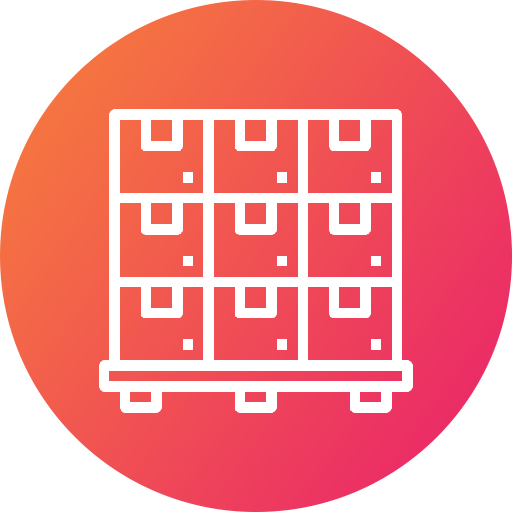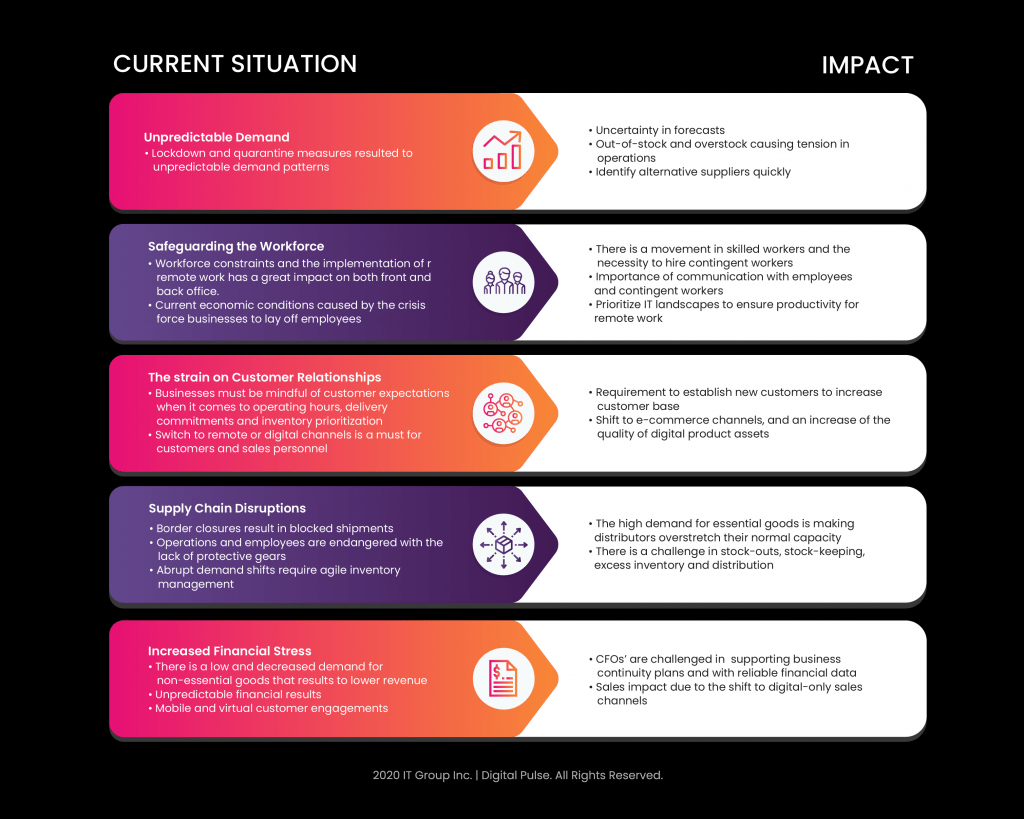
Navigating Wholesale Distribution and Logistics to Emerge Stronger Digitally
Downloadable Resources
Navigating Wholesale Distribution to Emerge Stronger Digitally

Industry Impact of COVID-19
COVID-19 has created a huge impact on a global scale that led to an unprecedented worldwide economic disruption.
The impact of COVID-19 to distributors vary from the customers they are serving. For some (especially the essential goods), there is a highly increased demand and some goods have a significant decrease in demand. As an example of the scenario, grocery distributors are challenged to keep up with the unpredictable demand of the consumers while restaurant distributors do not have anyone to serve due to business closures. Since there is a continuous shift of demand, it is hard to predict the strategy in the inventory and procurement side which can develop a bullwhip effect due to cashflow issues, decreased liquidity of customers and supplier production stoppage.
The unpredictability of consumer and customer behavior should be a heads up to wholesale distribution companies to assess and address supply chain disruptions, and workforce constraints. It will be challenging to shift from traditional strategies to innovative ones abruptly because forecasting models in the past may not work for the current situation today.


ITG to Help Enable
- There is a struggle in identifying alternative suppliers because distributors are focused on sourcing lowest cost suppliers
- Border shutdowns, supply restrictions, and transportation delays resulted to supply chain disruptions
- Business disruptions should be tracked daily regardless of the situation
- Distributors need to continually engage with their suppliers and consider their specific pain points so that they can be up to date with their response policies
- Warehouse delivery teams struggle to carry out uninterrupted operations due to government-mandated regulations for work policies while the rest of the workforce switches to remote work
- There is a need for additional support and resources for the employees who are working remotely
- Lack of up-to-date information from organizations regarding employees who are exposed to the virus or for those who are unable to return to work due to safety and preventive measures
- Efficient hiring and training must be done virtually with the growing number of unemployed numbers
- Businesses turn to flexible workforce mix in order to give service to the customers despite the shutdowns and demand disruptions
- There is a priority in finding skilled workers with highly-valued expertise
- Organization-wide visibility to ensure that external and service providers are managed effectively
- Business owners must provide tools and platforms to their remote workforce to ensure productivity
- Non-essential, traditional channels, and brick and mortar stores are closed which changes the way they engage with customers
- Customer service teams are not well prepared and insufficiently staffed to address the current challenges and business needs
- Businesses who are operating in a traditional and manual ordering systems are severely exposed dues to the shift of workforce dynamics
- Employees are using collaboration platforms that support eCommerce systems to support registration, orderings, provisioning, and billing.
- Supply chain resiliency is not a top priority because they are more focused on cost efficiency
- There is a need to categorize supply risk and make supply chains with a main focus on resiliency to help:
- Look for and manage an alternative source of supply
- Understand the limitations of suppliers that includes flex ranges, buffer stock
- Determine which suppliers are at risk and know which components are single-sourced
- Prioritize and segment demand and supply
- Determine obsolete and excess risk to avoid it
- Set up a plan to deal with piled-up demand and supply shortages to help operations to start and catch up
- Distributors must know that they are the first responders in the supply chain (ensuring product availability, critical operations, and responsiveness) especially for essential goods to keep the economy going at all costs.
- There is a huge pressure for distributors to keep the liquidity as non-essential businesses are unable to pay their bills and some are forced to shut down.
- A lot of pressure is placed on CFO’s to make sure that financial data, manage cost and plans are in place for internal and external systems.
- There is a struggle in identifying alternative suppliers because distributors are focused on sourcing lowest cost suppliers
- Border shutdowns, supply restrictions, and transportation delays resulted to supply chain disruptions
- Business disruptions should be tracked daily regardless of the situation
- Distributors need to continually engage with their suppliers and consider their specific pain points so that they can be up to date with their response policies
- Warehouse delivery teams struggle to carry out uninterrupted operations due to government-mandated regulations for work policies while the rest of the workforce switches to remote work
- There is a need for additional support and resources for the employees who are working remotely
- Lack of up-to-date information from organizations regarding employees who are exposed to the virus or for those who are unable to return to work due to safety and preventive measures
- Efficient hiring and training must be done virtually with the growing number of unemployed numbers
- Businesses turn to flexible workforce mix in order to give service to the customers despite the shutdowns and demand disruptions
- There is a priority in finding skilled workers with highly-valued expertise
- Organization-wide visibility to ensure that external and service providers are managed effectively
- Business owners must provide tools and platforms to their remote workforce to ensure productivity
- Non-essential, traditional channels, and brick and mortar stores are closed which changes the way they engage with customers
- Customer service teams are not well prepared and insufficiently staffed to address the current challenges and business needs
- Businesses who are operating in a traditional and manual ordering systems are severely exposed dues to the shift of workforce dynamics
- Employees are using collaboration platforms that support eCommerce systems to support registration, orderings, provisioning, and billing.
- Supply chain resiliency is not a top priority because they are more focused on cost efficiency
- There is a need to categorize supply risk and make supply chains with a main focus on resiliency to help:
- Look for and manage an alternative source of supply
- Understand the limitations of suppliers that includes flex ranges, buffer stock
- Determine which suppliers are at risk and know which components are single-sourced
- Prioritize and segment demand and supply
- Determine obsolete and excess risk to avoid it
- Set up a plan to deal with piled-up demand and supply shortages to help operations to start and catch up
- Distributors must know that they are the first responders in the supply chain (ensuring product availability, critical operations, and responsiveness) especially for essential goods to keep the economy going at all costs.
- There is a huge pressure for distributors to keep the liquidity as non-essential businesses are unable to pay their bills and some are forced to shut down.
- A lot of pressure is placed on CFO’s to make sure that financial data, manage cost and plans are in place for internal and external systems.

